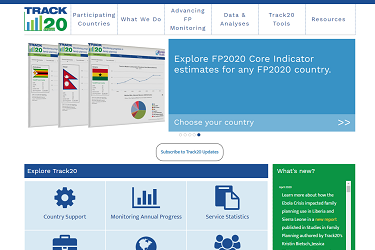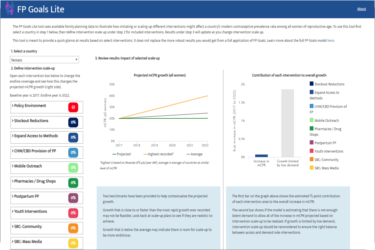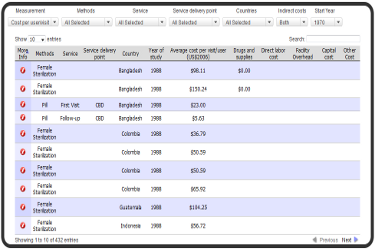Family Planning
FamPlan projects family planning requirements needed to reach national goals for addressing unmet need or achieving desired fertility.
It can be used to set realistic goals, to plan for the service expansion required to meet program objectives, and to evaluate alternative
methods of achieving goals. The program uses assumptions about the proximate determinants of fertility and the characteristics of the
family planning program (method mix, source mix, discontinuation rates) to calculate the cost and the number of users and acceptors of
different methods by source.
Track20 monitors the progress of the global FP2020 initiative by building country capacity and producing annual family planning indicator
estimates in the world’s 69 poorest countries.
The FP Goals Lite tool uses available family planning data to illustrate how initiating or scaling up different interventions might affect a
country’s modern contraceptive prevalence rate among all women of reproductive age. To use this tool first select a country in step 1 below,
then define intervention scale up under step 2 for included interventions. Results under step 3 will update as you change intervention scale up.
This tool is meant to provide a quick glance at results based on select interventions. It does not replace the more robust results you would get
from a full application of FP Goals. Learn more about the full FP Goals model here.
The Family Planning Estimation Tool (FPET) is a web application that is a country-specific implementation of the estimation approach for contraceptive
prevalence and unmet need for family planning used by the United Nations Population Division (UNPD). Refer to UNPD's World Contracpetive Use 2017 for
the most recent database and estimates.
The Family Planning Market Analyzer combines data from Demographic and Health Surveys and FP2020's projections of modern contraceptive prevalence
(mCPR) to allow users to explore potential scenarios for a total market approach (TMA). The tool can be used to inform TMA discussions by providing
key results linked to probing questions—for example, if the private sector doubled its role in implant provision how many more services would
need to be provided.
The RESPOND Project recently completed a secondary analysis of 40 Demographic and Health Surveys to explore the characteristics of users
and nonusers of different FP methods. Indicators explored include parity, ideal number of children, wealth quintile, urban vs. rural
location, and source of method, with methods categorized as traditional, short-acting, or long-acting and permanent. The findings from
this analysis have been compiled into this user-friendly web-based tool.
A critical gap in the information needed for family planning policy, planning and program expansion is a centralized source of costing
data that is easily accessible to policy analysts, country officials and implementing organizations. This Family Planning cost database
provides planners an easy to access resource on the comparative costs of family planning methods and service delivery points. The data
are available both in terms of user costs and costs per couple year of protection.







